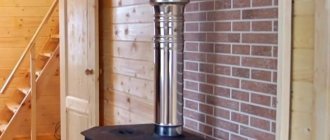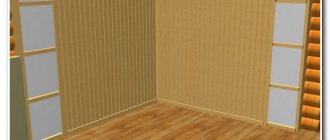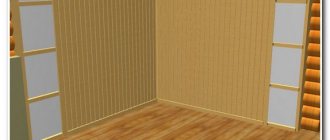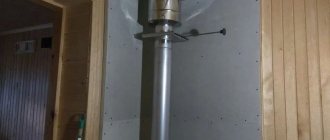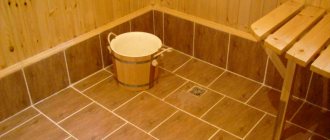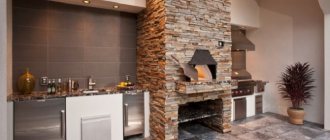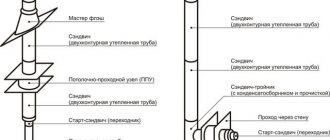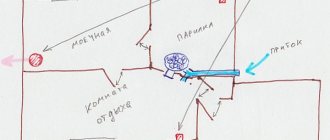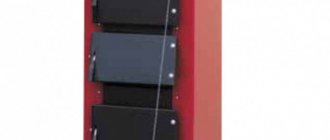Home / Installation, repair, maintenance / Decorating the walls near the stove - what heat-resistant panels are used?
To prevent such a nuisance as a fire from happening, heat-resistant materials are used to decorate the walls near the stove. Any such heat source not only heats the air in the room, but also heats up itself very strongly and therefore, the surrounding partitions can easily catch fire. In our case, these are walls and floors.
When is it necessary to create fire walls?
Fire safety requirements for the installation of stoves and fireplaces are set out in a number of GOSTs and SNiPs. They are summarized in the “Code of Rules” - SP 7.13130 “Heating, ventilation and air conditioning”, approved by Order No. 116 of 02/21/2013. by the Ministry of Emergency Situations of Russia. The requirements of the joint venture boil down to compliance with the temperatures allowed on the surfaces of the heating device and the establishment of distances between the heated surfaces of the furnaces and combustible structures. The following poster illustrates these requirements
If there is a forced reduction in the specified dimensions of fire-resistant offsets and cuts, it is necessary to use non-combustible materials for wall finishing. Considering the high decorative qualities of modern non-combustible finishing materials, their use is justified not only to prevent fires, but also in interior design projects in general.
Application of protective screens
Screens are shields made of brick or metal that protect walls from intense thermal radiation. Similar protection is used when installing metal stoves.
- Metal screens are made from steel or cast iron sheets, these
casings surround the heat source with a distance of 3-5cm.
Advice! When purchasing a metal sauna stove, you should give preference to a model equipped with a metal casing. Its cost is not much higher, but the issues of wall insulation are eliminated.
Additional frontal or front shielding, which is located on the walls depending on the location of the stove, will not hurt. The protection guarantees the wood from overheating, reducing the temperature by 100 degrees or more, and provides the opportunity to save space in the steam room. A stove protected by a casing can be installed at a distance of 50-55cm from the wall.
Installation of screens is simple. The casing, equipped with legs, is secured to the floor by side or front screens - with galvanized nails or self-tapping screws.
- Brick screens are masonry used to cover the stove with
on all sides, the same casing, only made of brick. Another method is to lay half a brick between the firebox and a wall made of solid fireclay bricks laid on a solution of clay and cement. The width of the wall should be 120mm, although there is an opinion that it is permissible to put 60mm in a quarter of a brick, but it should be remembered that in this case the thermal insulation value is reduced by exactly half. It is recommended to raise the height of the masonry 20-30 cm above the surface of the firebox, but if you raise it to the ceiling, it will not be worse.
The screen should be placed at a distance of 10-15cm from the wall, 5-15cm from the stove, that is, the space saving is 30-40cm
Important! Functional openings for heat exchange should be made at the bottom of the masonry.
Protective screens are effective; they reduce the temperature to a level acceptable when using high-temperature fuel units. The same function is performed by wall cladding made of non-combustible materials.
Scope of use
The scope of use of fire-resistant materials is somewhat wider than non-combustible materials for finishing walls under a boiler, stove or fireplace. It also includes materials used for the construction and decoration of the heating devices themselves. Refractory bricks are used for laying the internal surfaces of stoves and fireplace inserts. Fire-resistant glass inserts are tripled in stove doors and fireplace protective screens. External finishing of heating devices is not only fire-resistant plaster for the stove, but also tiles and clinker used as facing material
Insulation of steam rooms
In addition to protecting the surfaces adjacent to the stoves, baths (steam rooms) and saunas must be provided with reliable insulation to ensure that the required temperature is maintained.
To insulate steam rooms from the inside, the following techniques can be used:
- the use of heat-insulating non-combustible materials that are most suitable for areas of high humidity in the bathhouse (usually stone or mineral wool is used for these purposes);
- arrangement of vapor barrier protection;
- creation of screens based on non-flammable aluminum foil.
Before starting insulation work, you should prepare the surfaces for laying the selected type of heat-insulating material, which is spread in the niches of the sheathing. A vapor barrier layer is installed on top of the insulation, which can be used as an ordinary polyethylene film.
A special foil film, spread directly on the insulating layer, is also suitable for arranging such protection. Currently, special types of thermal insulation material with a foil layer already present on their surface are on sale.
Decorative lining is placed on top of protective coatings and films, which can be ordinary lining, most common in a bathhouse, or any other heat-resistant material.
Types of non-combustible wall products
Non-combustible wall products include heat-resistant plasters and mortars intended for laying heat-resistant ceramic tiles:
- terracotta;
- majolica;
- clinker tiles;
- fireclay tiles.
There are many recipes for plaster and mortar for laying ceramics.
Advice! For an amateur finishing his first stove, it is easier to purchase a ready-made mixture for plastering or laying tiles. It’s even easier, although more expensive, to entrust the matter to professionals!
An example of a fireplace with a firebox and a closed glass door. The presence of glazed doors, on the one hand, protects the interior from contamination by combustion products, and on the other, allows you to admire the fire.
Advice! Glass must be washed after each fire. Without this, they will become smoky and quickly lose transparency. This can be done with special detergent compositions for fireplace glass, or, in their absence, with powdered dishwashing detergent. The glass in the doors is tempered. Powdered detergent will not harm it.
SKL products
SCL - calcium silicate sheet - environmentally friendly material. Does not contain harmful substances and carcinogens. Retains mechanical properties - strength and hardness when heated. Contains:
- paper pulp - 10%;
- quartz powder 45%;
- cement – 40%;
- additives that increase the mechanical properties of the material – 5%.
A decorative layer with ultraviolet painting is applied to the front side of the SC sheet. The levels of fire and moisture resistance allow the use of SCL both in the external and internal decoration of buildings. This material is good for finishing rooms with high humidity - household rooms, baths, bathrooms. The ability to resist fire allows the use of SCL for finishing the walls and ceilings of rooms near the hot surfaces of the stove and fireplace.
SML products
SML - glass-magnesium sheet - is a relatively new material that has strength, flexibility, moisture and heat resistance. It includes:
- magnesium oxide – 40%;
- magnesium chloride – 35%;
- fine wood shavings – 15%;
- extruded perlite – 5%;
- additives – 4%
- fiberglass – 1%.
LSU does not have a harmful effect on the human body, therefore it is used in interior decoration. High fire resistance up to 1000°C allows it to be used as fireproof panels for interior wall decoration near heating sources and open fire.
GKLO products
GKLO is a fire-resistant plasterboard sheet. According to GOST 32614-2012, developed jointly with the Knauf company, and put into effect on the territory of the Russian Federation in 2015, this material is designated by the letter F - “fire-resistant boards”. Its fire resistance must be at least 20 minutes when exposed to open flame.
The heat resistance of gypsum plasterboard is achieved by introducing special additives into gypsum that increase the resistance of the material to high temperatures and prevent smoke from occurring in a fire. To facilitate recognition, the surface of the gypsum board is painted light pink, and the markings are done in red. Knauf Fireboard - the most fire-resistant product from Knauf - has an additional reinforcing layer of fiberglass. Used as fire-resistant cladding for walls and ceilings.
Minerite slabs
One of the most effective ways of protection. Ninety percent of the slab composition is ordinary gray or white cement, which serves as an excellent heat insulator. The remaining ten percent of the composition is reinforcing fiber and mineral fibrous material. Outwardly, they are not always beautiful and therefore they are often additionally decorated with artificial stone, tiles or painted.
Important: mineralite can easily withstand heating up to 150 degrees, but to more effectively protect the walls, it is better to leave an air gap between the mineralite sheet and the insulated surface. If this is undesirable or impossible, then the mineralite sheet is mounted on a heat-resistant substrate, which increases the effectiveness of protecting the structure.
In addition, the sheets can be deformed from heating and when installing two sheets at once, it is necessary to leave small gaps for temperature deformation.
Fireproof ceilings
In the event of a fire, hot air and flames move upward to the ceiling of the room. Therefore, it is important to take the necessary measures in advance to ensure that a fire ceiling does not become a source of additional dangers for people caught in the fire zone. Non-combustible ceilings can be:
- Painted. Non-combustibility here depends on what material the interfloor ceiling is made of. Concrete is good! The painting was done with silicate or silicone paint - even better! Concrete does not burn. These paints also do not support combustion.
- Wallpapered. With a base on which the wallpaper is glued, as in step 1. The wallpaper itself can also be chosen as heat-resistant - based on fiberglass and metal threads.
- Tensioned. The ceiling, made of polyester impregnated with a fire-retardant compound that protects against fire, is relatively safe. Polyvinyl chloride is also considered heat-resistant, but when exposed to direct fire, it ignites and emits a large amount of gases harmful to humans. It should be used with caution.
- Plasterboard. To be considered non-flammable, such a ceiling must be made of gypsum plasterboard and painted with non-flammable paint.
- Hanging. Such ceilings are made on non-combustible metal frames made of SKL, SML or metal composite elements. The requirement of non-flammability is met.
Bath waterproofing
Waterproofing is necessary so that the building materials from which the bathhouse is built, as well as the layers of insulation placed on it, do not get wet and do not lose their protective properties. Waterproofing can be done either using roll insulation or using special water-repellent coatings.
It is especially important to carefully consider the waterproofing of the floor, since this is where a lot of water will flow. For this purpose, a leak-proof concrete floor with a backing made of waterproofing material is often used. Another option is to make a leaky floor with special gaps where excess water will drain.
Manufacturers and prices
When purchasing heat-resistant materials for finishing walls near the stove, it is necessary to decide the issue of choosing manufacturers and prices. It is desirable that the manufacturer of the purchased material is known, and the price is close to the generally accepted price at the time of purchase. An example of such popularity among the construction community is the Knauf company. The quality and range of products, as well as a reasonable pricing policy, allowed it to occupy 70% of the plasterboard market in the Russian Federation. Since the market situation is fluid, it makes no sense to name specific prices for materials. They depend on the region and the state of affairs in the industry. One should, however, remember the popular wisdom: “You shouldn’t chase after cheapness, priest!..”
Advice! A developer who does not want to overpay when purchasing materials should not delegate this work to a foreman. In this case, inflated prices and costs are inevitable!
What parameters to pay attention to when choosing
When choosing thermal insulation, you need to pay attention to several points. Important criteria are the price of materials and work, as well as the installation method that will be carried out. At the same time, it is necessary to carefully analyze the characteristics of the selected option. These characteristics include:
Thermal conductivity. It is important that the piece of consumable you choose is not raw, otherwise it will not cope with the plans assigned to it.
Thermal conductivity depends on the degree of humidity, since water has the ability to transmit heat better than air. Non-flammable substances retain heat inside the product.
The porosity of the heat insulator. There are closed or open pores on the elements.
It is important to ensure that they are evenly distributed over the surface; these pores are involved in heat exchange and air circulation.
Rapid water absorption. This criterion shows how much water has accumulated and how much of it can be retained. To test water absorption, you need to place the item in a humid environment.
Density and vapor permeability. Density depends on its mass in combination with the volume of the source. The vapor permeability level shows how much steam can pass through non-combustible wall insulation in a certain period of time.
Resistant to biodegradation. If fire-resistant materials have high biological resistance, they will be able to resist insects and fungi in conditions of constant or simply high humidity.
Fire resistance and heat resistance. Emphasis on the flammability and combustibility of the material.
If the insulation can withstand flames, then the level is high.
Combustible substances are added, so during heating the level of heat reached is checked, as well as the stability of the properties during it. At high temperatures, characteristics may decrease, as well as strength, and as a result, quality.
Frost resistance. To check this parameter, insulating structures are placed in low temperatures and analyzed to see if their properties have been lost during freezing and thawing.
Care Tips
In houses with stove heating, maintaining the stove and fences that protect the combustible structures of the house from overheating in good condition is the key to trouble-free living for its owners. Fire is no joke, and there are no trifles in observing fire safety rules! If they say that a sheet of metal measuring 500x700 mm is needed in front of the furnace loading door, it should be there!
Every year, before the start of the heating season, you should check the condition of the heating appliances at home. It is necessary to check whether the heat-resistant plaster of the stove is damaged, whether there are cracks in the chimney, or whether the facing tiles have fallen off. All identified defects must be corrected in a timely manner.
Fire-resistant panels are an excellent guarantee of the safety of your property.
